
Solid waste utilisation
Steel producer to join Sea Cargo Charter to reduce Scope 3 emission
First of its kind in the world
SO4
SE
Steel is integral to economic development and nation-building. However, steelmaking is a resourceintensive process and creates environmental impact in the form of emissions and effluents. We are committed to using the most efficient production routes, minimising waste generation and mitigating the negative impact on the environment.
Our approach to managing natural capital is underpinned by our strategies on low-carbon transition, reducing dependence on freshwater consumption, pollution control, maximising value from waste, exploring opportunities in the circular economy, and enhancing biodiversity across the value chain.
The Company focusses on operational excellence through the ‘Prevent, Reduce, Recover, Reuse and Recycle’ approach. We continue our pursuit of establishing best-in-class facilities and channelising investments to upgrade manufacturing and distribution facilities. We have implemented environmental management systems in accordance with ISO 14001:2015, which provides the necessary framework for managing compliance and improving environmental performance. In FY 2021-22, ₹554 crore was invested on environmental management system upgradations, focussed on the improvement in air emissions, CO2 abatement, water management and imbibing circular economy principles. We maintain state-of-the-art accredited laboratories for environmental performance assessment.
Clean air is fundamental for all. Tata Steel responsibly strives towards minimising its air emissions to ensure healthy air quality in the communities where it operates. The key lever in our journey so far in minimising air emission impact was to establish and maintain state-of-the-art air pollution control equipment. It is essential that we stay updated with global developments in pollution control technology. Disjointed data sets captured annually across all locations were unified through digitisation of all environmental KPIs to an environment canvas, creating a ingle version of truth. We are using online audits, unified dashboard and real-time measurements to gain better and meaningful insights. Our continuous efforts have resulted in an overall reduction of 29% in stack dust emission intensity since FY 2017-18.
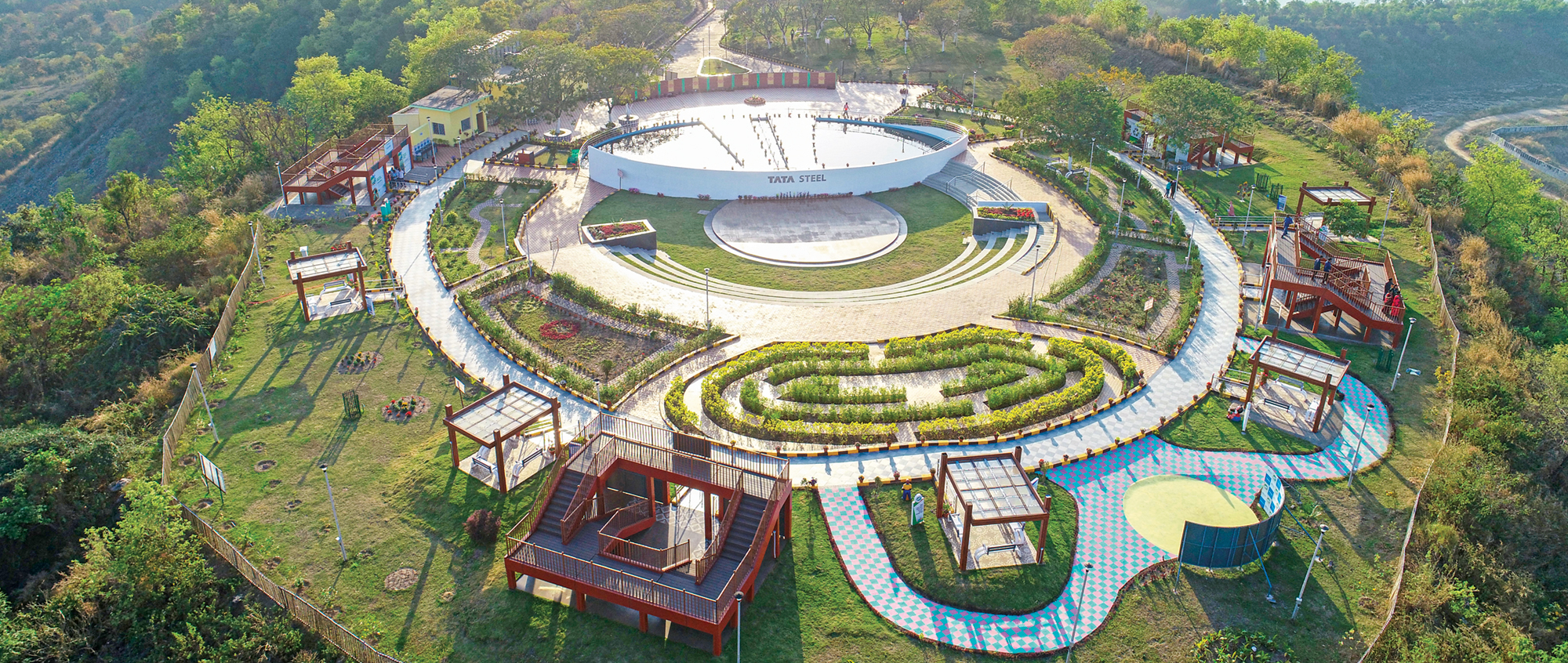
JN Tata Park, West Bokaro
At Tata Steel Jamshedpur, we are replacing existing coke oven batteries 5, 6 and 7 (combined 1 MnTPA capacity) with new coke oven batteries 6A and 6B (1 MnTPA), having technologies for latest pollution control equipment, higher energy efficiency and lower fugitive emissions. Additionally, we are conducting Source Apportionment studies in the steel plant and surrounding area (20-kilometer radius) to identify key sources of air pollution, their contribution to the overall ambient air quality in the region and thereby develop air quality management plans to improve the ambient air quality of Jamshedpur. Going forward, we seek to enhance our capability to assess real-time impact and introduce predictive analysis of environment pollution. We are developing Process Environment Management (PEM), a first-of-its-kind framework, to integrate process parameters with environment performance indicators, thus enabling agile business decision-making.
At our UK operations, we pursue targeted investment in environmental control technology to achieve reductions in our impact. In the summer of 2021, we commissioned a new emissions control unit at our Port Talbot sinter plant after an investment of more than £20 million in new filtration systems. These are now delivering a substantially reduced level of particulate emissions.
At our Netherlands operations, we launched the ‘Roadmap Plus’ programme in December 2020 (worth ~€300 million) intended to improve local environmental performance between 2020 and 2025 by addressing the concerns of the surrounding community on areas such as dust, noise and odour.
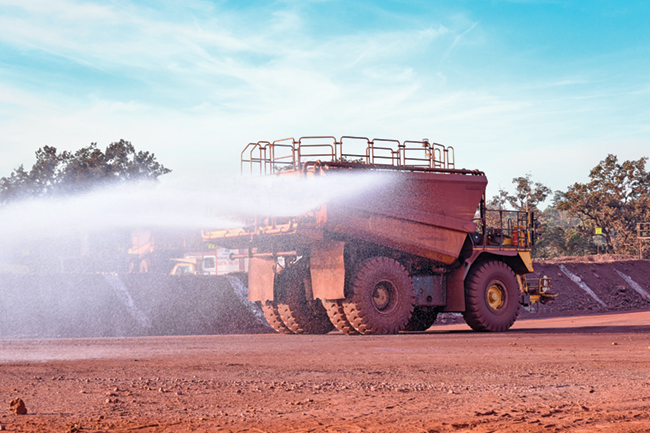
Dust suppression at Noamundi Mine through water sprinkling
Through Roadmap Plus, Tata Steel Netherlands has already made significant improvements in reducing emissions in recent years. We have finalised a new facility for processing iron residues and installed new noise walls at the scrap yard. Odour emissions from multiple sources like furnaces at Coking Plant 2 and heating of steel pans at the steel plant have already been reduced by 50%.
Over the next year, we plan to take up >20 measures to ensure the realisation of the environmental targets set for the programme. A major project that we are taking up under this programme is a new high-tech environmental installation at the Pelletising Plant, that will significantly contribute towards reduction of emission of heavy metals and particulate matter using a new technology that has not yet been applied on this scale elsewhere in the steel industry
We are committed to taking care of the environment and the community in close consultation with the community, province and other stakeholders. We are undertaking concrete actions in the short term, while continuing to invest in sustainable solutions to produce climate-neutral steel in the long term.
Water is a key material issue for Tata Steel as most of our operations in India are located near rivers (Jamshedpur and Gamharia plants near the Subarnarekha river, and Kalinganagar and Meramandali plants near Brahmani river). These plants fall in low-medium water stress areas as per the WRI (World Resources Institute) Aqueduct. We are taking a holistic approach to water management by adopting the water conservation philosophy, based on 4R principles of reduce, reuse, recycle and recover, with continuous efforts to transform steelmaking into a more water efficient business.
Steel plants use a large amount of water for a variety of purposes, including cooling, dust suppression, cleaning, and temperature control (heat treatment). Pertaining to this, we use the approach of reduction at source as much as practically possible, by identifying the root of the problem, debottlenecking and reducing discharge into outfalls.
Use of large amount of water also generates huge quantity of effluents, which contain suspended solids, dissolved substances and chemicals. We reuse these effluents after minimal treatment for low-end applications like coke quenching, blast furnace slag quenching, steel melting shop slag quenching, sinter/pellet mixing, gas cleaning plant, horticulture, dust suppression, etc. To minimise the withdrawal of fresh water from rivers and to make Jamshedpur a zero-sewage discharge city, we are reusing the treated municipal wastewater from two sewage treatment plants (STPs) of 45 and 16 MLD (million litres per day) capacities into our operations. We have collaborated with Ecolab to assess the water use efficiency in an integrated manner.
All our sites are continuously taking actions to prevent the risk of contaminating local water resources and achieving zero effluent discharge. The following new technologies have been adopted by Tata Steel for the prevention of water pollution:
During the last year, we have successfully completed the rejuvenation project at the Cold Rolling Mill (CRM) Bara (Jamshedpur) resulting in the creation of larger rainwater harvesting facility, improvement in the water table of the local area and increase in biological diversity.
The specific freshwater consumption of our Jamshedpur Works (@2.18 m3 /tcs in FY 2021-22) is one of the lowest in the steel industry in India. Also, upgradation of the common effluent treatment plant (CETP) is on track at Jamshedpur Works to make it a zero effluent discharge facility.
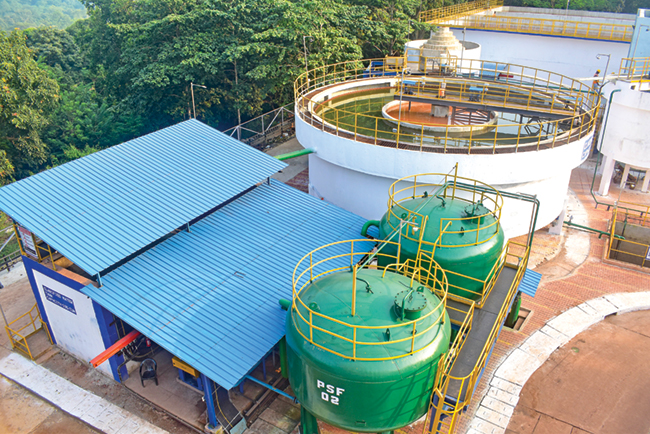
Water treatment plant at Noamundi, Jharkhand
Producing steel from the infinitely recyclable ferrous scrap has a lower carbon footprint, as opposed to producing it from iron ore. India is a net-importer of scrap and deficient in producing high quality shredded scrap, which improves productivity in steelmaking. Tata Steel is the first company to set up a scrap collection and shredding facility at Rohtak (Delhi-NCR) and has plans to replicate such facilities across India. The Steel Recycling Business completed the first year of operation from its Rohtak Plant. The shredder was commissioned virtually under challenging conditions of COVID-19. The plant clocked ~112 KT dispatch with a revenue of ~₹460 crore in FY 2021-22.
The scrap is procured through the digital FerroHaat app, a first-of-its-kind in the world. Over 180 vendors have been registered on the app for supply of scrap.
There has been a dedicated effort to increase scrap charging in our steel melting shops, which is one of the key enablers for reduction in carbon footprint. In FY 2021-22, we increased clean scrap charging in Tata Steel India steel melting shops to 6.6% as compared to 4.8% in FY 2020-21. We are continually investing in augmenting the infrastructure for scrap management and charging in our India operations to reach the internal benchmark of our European steelmaking facility at IJmuiden. Our Thailand facilities use 100% steel scrap as primary raw material.
Tata Steel has been pioneering in value creation from waste and by-products in its quest to contribute to a sustainable ecosystem in the iron and steel industry. Tata Steel aims for a ‘Zero Waste’ goal using the 3R (Reduce, Reuse & Recycle) principles of circular economy. We handle ~15 MnTPA of by-products spanning across 25+ product categories comprising more than 250+ Stock Keeping Units (SKUs). These value-added by-products serve as key raw materials for various industries like cement, chemical, construction, etc. In FY 2021-22, Tata Steel Jamshedpur and Tata Steel Kalinganagar achieved 100% solid waste utilisation and horizontal deployment of best practices in Tata Steel Meramandali helped to achieve 97% solid waste utilisation.
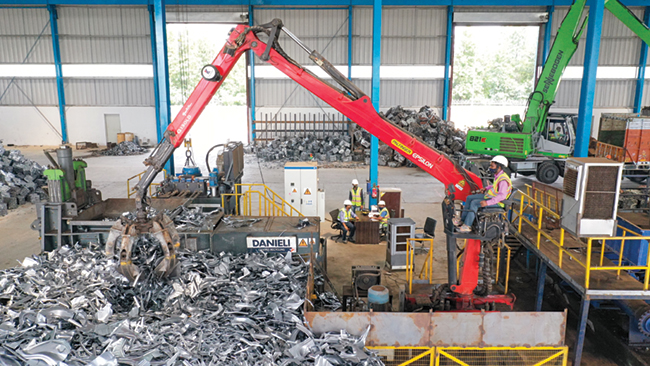
Steel Scrap Recycling Plant at Rohtak, Haryana
Solid waste utilisation at Tata Steel Jamshedpur and Tata Steel Kalinganagar
Solid waste utilisation at Tata Steel Meramandali
We have been investing in research to develop technologies for reuse of iron and steel slags. Our journey can be comprehended through the pioneering and materialised technologies as well as the innovation pipeline pertaining to slag-based products. Through an in-house developed process of accelerated weathering of steel slag (basic oxygen furnace slag), we developed manufactured aggregates branded as Tata Aggreto. This is India’s first steel slag-based branded product, extensively used in the construction of national highways, which has helped in conserving natural aggregates and minimising our environmental footprint. Tata Nirman, another product based on steel slag fines, has been established as a raw material of choice for the brick manufacturing industry. Through innovative initiatives aimed at supporting the farming sector, a multi-nutrient soil enhancer Dhurvi Gold, has been developed, which serves to provide low-cost soil conditioning solutions. Besides steel slag, various downstream products have been developed from blast furnace slag, such as ground granulated blast furnace slag (GGBS) and activated GGBS, which can be used as partial replacement of Ordinary Portland Cement (OPC) for making concrete, thereby positively impacting the carbon footprint of cement manufacturers.
Tata Steel has been adjudged winner of ‘Indian Circular Economy Award 2021’ under the large enterprise category during the Circular Economy Symposium organised by FICCI. The award recognises Tata Steel’s practices to accelerate its business towards a circular model as the most innovative and impactful. The Company has also won the ‘Excellence in 3Rs (reduce, reuse, recycle)’ Award by CII during the International Conference on Waste to Worth, for the second consecutive year, for demonstrating innovative 3R initiatives in managing own wastes.
The Company is committed to achieving 100% material efficiency while sustaining solid waste utilisation at 100% level across all its locations and increasing EBITDA by 2.4x from by-products business.
Tata Steel has been actively working with several organisations to enhance its performance in biodiversity conservation and significantly reduce its impact on the ecosystem. Our Indian operations are not located in any of the identified biodiversity hotspots or protected areas. During FY 2021-22, we developed the Biodiversity Management Plans (BMP) for Khopoli and Gamharia. We have developed BMPs for 13 locations and plan to cover 100% sites to assess the impact and dependency of direct operations on biodiversity by 2024. We have planted over 5.6 lakh saplings of native species across locations. We have also established a tree bank for sapling supply at Jugsalai Muck Dump (JMD) with a capacity of ~ 2 lakh per year and conducted a plantation drive in 4.8-hectares area at Cold Rolling Mill (CRM) Bara complex at Jamshedpur. Spread over an area of 43.25 hectares and housing 465 animal species, Tata Steel Zoological Park Jamshedpur aims to preserve wild flora and fauna and help them propagate in natural captivity. During the pandemic, the zoo leveraged digital media (virtual tours, online webinars, theme-based posters, online quiz, etc.) for wildlife awareness creation and conservation programmes. During the year, we developed the Miyawaki Forest at Khopoli operations, taking the overall forest area cover to ~10 acres in the past three years.
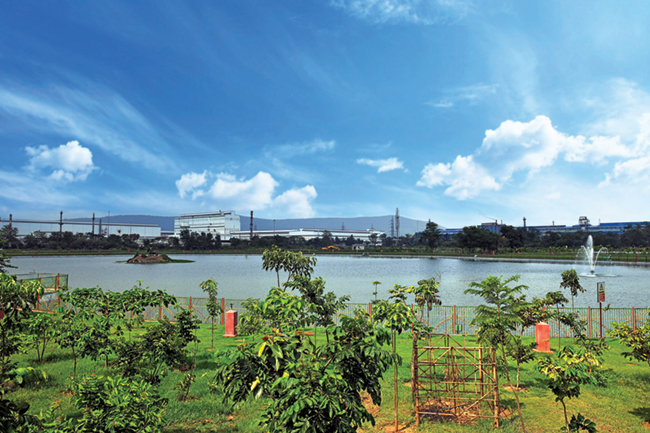
Rejuvenated CRM Bara Pond at Jamshedpur, Jharkhand
At our UK operations, we are guardian to large areas of natural habitat, including several Sites of Special Scientific Interest (SSSI). In addition to meeting our responsibilities for protected sites, we also look for opportunities to encourage biodiversity on other landholdings and thereby contribute to protecting the natural heritage of UK’s landscape. Former blast furnace cooling lagoons at our Shotton site are now a haven for wildlife. Attracting 12 nesting pairs of common tern in 1970 with the creation of a small raft on the lagoon, the area has become home to one of the UK’s largest colonies of this vulnerable bird species and has seen over 20,000 chicks fledge successfully. The site has been a nature reserve for 50 years and a designated SSSI since 1990. In 2021, a project team of apprentices, volunteers and supply partners refurbished the colony, creating new tern islands on the lagoon, connected by a new steel walkway. The project, assisted by a Welsh government grant, involved the donation of steel for a base and moving 130 tonnes of shingle from the shore onto the nesting islands by helicopter to refurbish the islands, creating a nesting site that the migratory birds will return to, for years to come.
To accelerate our efforts in becoming a leader in product sustainability, we strive to use the Life Cycle Assessment (LCA) tool effectively to understand our products’ environmental impact as well as to use its outcomes for product-related environmental disclosures. Taking the initiative forward of increasing the coverage of manufacturing sites and products under LCA, this year, we completed the LCA study for all the products manufactured at Meramandali, CRM Bara (Jamshedpur) and TSLPL Gamharia, covering a total of eight different product categories. We also carried out the LCA study for our structural tubes and hollow section products (sold under the brand Tata Structura) covering seven different production units. During the year, we also carried out an LCA study for one of our Fibre Reinforced Polymer products to understand its life cycle environmental impact. Accordingly, we are embedding LCA in the products of our new businesses to understand and improve their environmental performance.
In continuation of our comparative LCA between HabiNest and Conventional Reinforced Cement Concrete structure, we found that the HabiNest installations have made significant environmental savings of 18-64% when analysed over six different LCA categories in comparison to the conventional structure. During the year, the HabiNest comparative LCA study carried out for a project installed in FY 2019-20 got critically reviewed by a third party, which was found compliant as per ISO 14071:2014, ISO 14040:2006 and ISO 14044:2006. The review statement of the same is published under the Product Sustainability page of Tata Steel’s website.
As the first steel manufacturer to become an approved Environmental Product Declaration (EPD) programme operator in Europe, Tata Steel now has the ability to create product specific EPDs that comply with EN 15804 and ISO 14025 standards. Being able to supply product specific Type III externally verified EPDs, along with BES 6001 responsible sourcing certification, enables us to help our construction supply chains to accrue points under building certification schemes, such as LEED and BREEAM, on their building projects. In addition, the level of transparency and reporting afforded by the operatorship allows optimum resource decisions to be made and demonstrates the sustainability of steel and our steel building products.
During the year, we have ensured timely support to our customers who had requested product-related sustainability information. In the coming years, our focus will be to obtain eco-labels (GreenPro and EPD) for our key products as well as to maximise the coverage of our products across sites under LCA to support our customers with product-related sustainability information.
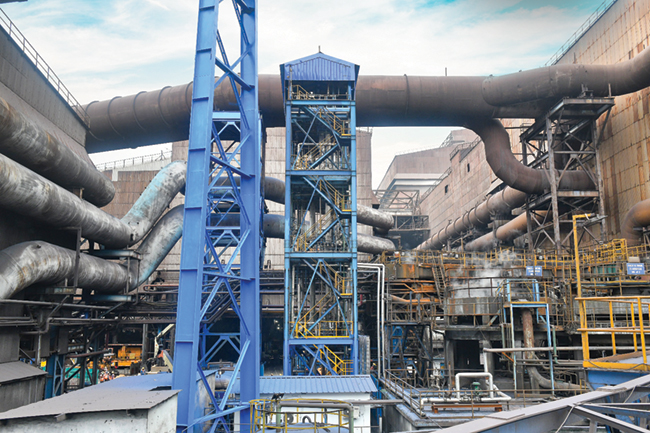
Commissioned India’s first plant for CO2 capture from Blast Furnace gas at Jamshedpur
At our European operations, providing sustainable solutions is at the heart of our new product development. In the past five years, we have launched 85 new products for the automotive, engineering and construction sectors, and many of these come with specific sustainable properties to make them lighter and long lasting. Our industry–leading sustainability assessment profiler helps us evaluate our new product development portfolio by considering environmental, social and economic issues over the complete product life cycle. The profiler guides our teams at each stage of product development, alerting them to key sustainability issues and trends, tracking progress and identifying value-creating sustainable product attributes. We have held over 100 working sessions with our automotive Original Equipment Manufacturers (OEMs) and their customers in recent years and have been able to develop jointly agreed roadmaps for decarbonisation, circularity and responsible sourcing. We are working with several stampers and motor manufacturers on future Electric Vehicle (EV) launches and are involved in a collaborative, UK government-funded (Innovate UK) project, which is looking at the use of electrical steels in EV motors. The CompETe project aims to deliver electric drive units with class-leading efficiency for increased vehicle range, coupled with high power and torque density, all within a lightweight and compact envelope. Tata Steel R&D and its construction business at Shotton are engaged in identifying and evaluating sustainable alternatives to current organic coated (pre-painted) steel (OCS) coatings that are mainly originating from petroleum-based raw materials. This work will provide opportunities for product improvement and/or new product development for differentiated OCS products using sustainable coatings, e.g., waterbased coatings, that are processable, using novel curing technologies and renewable energy.
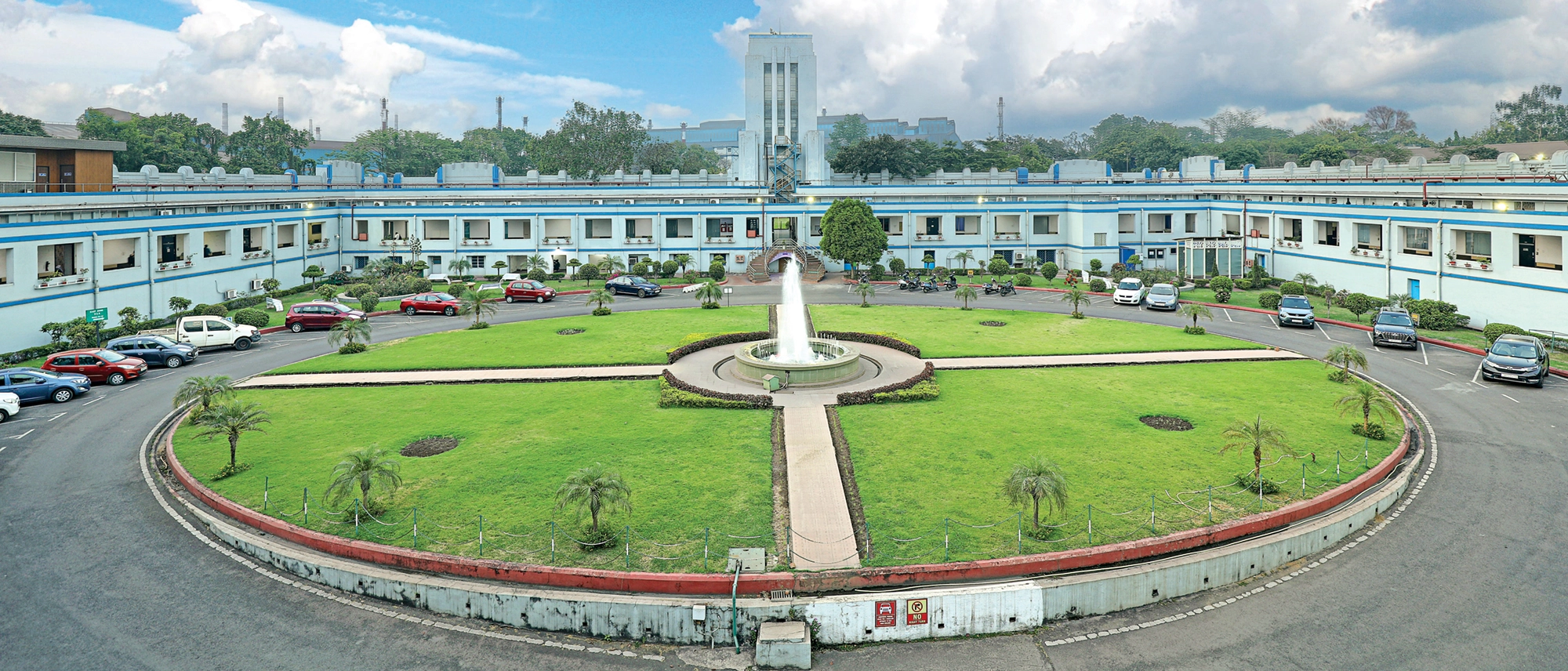
R&D building, Tata Steel Jamshedpur Works
Tata Steel in the UK is a consortium member of Seismic II, a UK Research and Innovation (UKRI)-funded project to streamline the construction of public sector buildings, such as schools and health facilities, meeting the government’s industrial strategy of reducing costs by a third, delivering buildings in half the time and with a 50% reduction in carbon emissions from the sector. With the aim of creating a standardised process for construction, the project uses data to enable a whole-life carbon assessment of the construction platform and has a focus on how components, such as floors, roofing and entire steel frames can be dismantled and reused. A demonstrator building at the BRE in Watford was completed in March 2022.
Iron and steel have been central to human development for three thousand years. Steel is the world’s most important and cost-effective engineering and construction material. Steel remains an integral part of the solution to climate change because of its unique properties like strength to weight ratio, ductility, longevity and, most importantly, infinite recyclability. These properties make steel the material of choice for industries like construction, infrastructure, automotive, white goods, and general application. Steel is also playing an important role in the transition to clean energy with its application in solar panels, wind turbines, hydroelectric dams, and EVs.
As per International Energy Agency (IEA), the steel sector emits 2.6 Gt CO2 annually, which accounts for 7-9% of global sectors for GHG emissions because of hard-to-abate metallurgical coal being used as a reductant in the iron making process through the Blast Furnace. The Blast FurnaceBasic Oxygen Furnace (BF-BOF) route accounts for 70% of global steel production currently.
Tata Steel is committed towards reducing its carbon footprint in production and through the life cycle of the product. We are one of the first companies in India to have endorsed the recommendations of Task Force on Climate-related Financial Disclosures (TCFD), with our Executive Director and Chief Financial Officer (ED&CFO) being a member of the Task Force. We are continually strengthening our production processes, supply chains, internal governance, disclosures, and policy advocacy to facilitate a transition to a low-carbon future.
At Tata Steel, climate action is an integral part of business strategy and risk management and is driven by the Company’s Board, with implementation through an organisation-wide governance structure. The CSR (Corporate Social Responsibility) & Sustainability Committee of the Board is responsible for providing directional oversight on our Climate Strategy, setting targets and reviewing progress periodically throughout the year. Additionally, the Risk Management Committee of the Board reviews Tata Steel Group level climate change-related risks periodically. The Chief Executive Officer and Managing Director (CEO&MD) along with the Executive Director and Chief Financial Officer (ED&CFO) are members of both these Board Committees.
Tata Steel Group’s CEO&MD drives the climate action programme for Tata Steel across all geographies, including its subsidiaries and reviews the same quarterly as Chairman of Apex Environment & Sustainability Committee. The CEO&MD also chairs the Technology & Innovation Management Committee, which drives the adoption of deep decarbonisation technologies like Hydrogen based steelmaking and Carbon Capture and Utilisation.
In 2018, a Centre of Excellence for GHG reduction and mitigation (cross-functional team with members from Operations, Technology and R&D, Sustainability, Finance and Engineering) was constituted under the leadership of Vice President Safety, Health & Sustainability to develop a climate change response roadmap, suggest policy level interventions, align our expansion/growth plans to a lowcarbon pathway and review implementation of projects.
The Company has also formed a Carbon Impact Centre (CIC) that is responsible for formulating carbon abatement projects. We use the Marginal Abatement Cost Curve (MACC) tool for prioritisation of projects and Internal Carbon Price (ICP) in India (in line with the EU Emission Trading Scheme) to ensure that new projects adequately reflect their intrinsic carbon price and also benefits of any carbon reduction.
Climate Change risks are part of the enterprise risk register and quarterly updates of these risks on likelihood, impact and status of mitigation strategies are reviewed by the Risk Management Committee of the Board.
We have identified four Strategic Objectives with long-term goals and action plans for each of them. Our Strategic Objective #4 is focussed on ‘Leadership in Sustainability’ wherein we have set specific long-term goals on carbon emissions along with a decarbonisation roadmap. Based on global scenarios on technology, government policy, consumer behaviour and Company’s asset configuration, our decarbonisation strategy is set out in three-time horizons, as mentioned below:
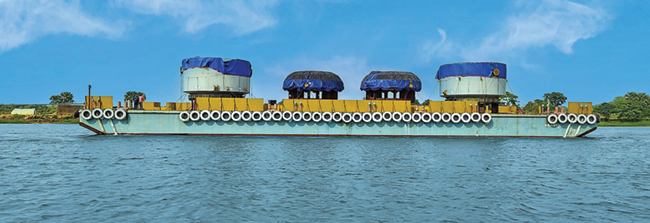
Completed the maiden multi-modal shipment, pioneered the use of inland waterways for transportation of steel products and machinery
We engage and support initiatives like ResponsibleSteelTM certification, development of steel sector guidance for science-based target setting, Net Zero Steel Pathway methodology project, Assessment of low-Carbon Transition (ACT), World Economic Forum’s Mining and Metal Blockchain Initiative, World Steel Association’s CO2 benchmarking and STEP-UP programs to chart long-term decarbonization pathway for the sector.
Tata Steel Group has been rated by CDP in Leadership band for Supply Chain disclosure. We have also been recognised as one of the top 25 most innovative Indian Companies by the Confederation of Indian Industry (CII) for ‘First-of-its-kind’ 5 tonnes per day CO2 capture plant and ‘First-in-World’ Digital Twin in Sinter Making in India.
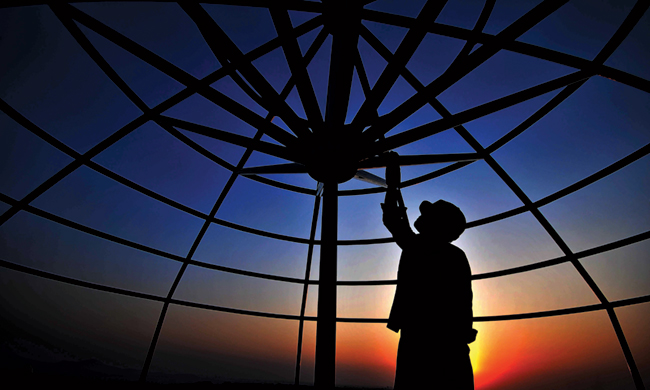
Eco-Park at Jugsalai Muck Dump in Jamshedpur
Tata Steel uses the company-wide integrated Enterprise Risk Management (ERM) process for managing climate change risks. The process identifies and assesses business risks through bottom up, top down and outside in perspectives so as to ensure comprehensive risk identification and minimise blind spots. Likelihood, impact, and velocity scores are assigned for each of the risks post a due-diligence process including scenario. Appropriate early warning indicators and mitigation strategies are identified for review, including by the Apex Risk Committee and Risk Management Committee (RMC) of the Board.
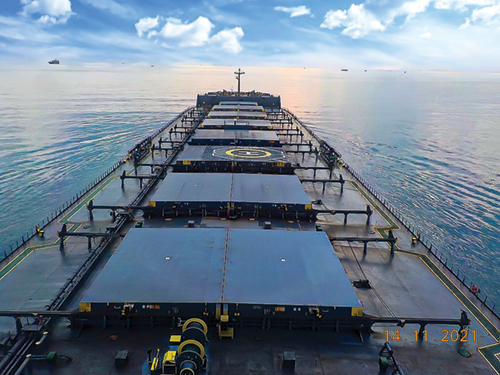
Deployed first Bio-Fuel powered ship for imported raw material
transportation
We are cognisant of the fact that both transition and physical risks associated with climate change will have an impact on our organisation’s operations, supply chain and financial planning. Stringent climate laws and regulations for accelerating the transition to a low-carbon economy, technology disruptions and shifting customer preferences to alternative materials may adversely impact profit margins, more so if our performance in abatement is inferior to our peers. Also, extreme weather events have become more frequent and severe in the recent years. On the other side, climate change also poses opportunities which include improved resource efficiency resulting in monetary savings, development of new products & services and access to newer markets, earnings from voluntary carbon markets, access to larger markets/customers requiring steel of low-carbon intensity.
In FY 2018-19 we conducted a third-party assessment to arrive at potential climate change risks and opportunities and estimate the likely impact of the risks on the Company’s strategy and financial planning. This assessment involved a holistic approach comprising internal stakeholder consultation, literature review, peer comparison and scenario analysis. We envisage that the way in which these risks and opportunities will play out in the future will depend on two fundamental factors, viz. Global Policy Response and Technology Innovation. Hence, we developed four scenarios based on these two factors considering various global warming temperature ranges to assess impact of these risks on our business strategy and financial planning. The four scenarios are – ‘India Role Model’, ‘Late Forced Transition’, ‘Climate Emergency’ and ‘Technology Breakthrough’. Out of the four scenarios, we believe ‘India Role Model’ (where there will be strong policy enablement and extensive innovation & technology advancement) is an ambitious scenario that outlines a technologically, industrially and economically possible way forward to restrict increase in global average temperature rise to below 1.5°C. It forms our base scenario for financial modeling and strategic considerations.
Extreme weather events like storm, drought, and cyclones due to climate changes have become more frequent in recent years. They not only lead to loss of lives and property but also cause business disruption and financial losses. Mitigation strategies are put in place to avoid significant delays in project execution.
These risks are site specific and are dealt as per site specific 'disaster scenario' planning. Our risk register covers climate change induced physical risks in the form of supply chain disruption (potential delays in vessel placements and loading/ unloading at ports/ sites/ stock yards due to adverse weather conditions) as well as capital project delays including unplanned costs and loss of production.
Tata Steel undertook several design-strengthening initiatives during the construction phase after 2013 cyclone during the erection of the Kalinganagar Plant. The severe cyclonic storm Yaas, ravaged the coastal states of Eastern India (where our major operations reside) with peak wind speeds of 140km/h. Our plants at Kalinganagar, Meramandali and Gopalpur in Odisha remained stable and without production cuts as the cyclone passed.
To future proof our key assets and proposed future capital projects, we have completed Natural Hazard and Climate Change Hotspot Analysis for key operating locations covering major upstream mining sites, steelmaking facilities and ports that are part of our major supply chain networks. The potential threats from different natural hazards, extreme events, and climate change were assessed based on globally accepted Climate Change Scenarios (RCP 4.5 and RCP 8.5) for a timeframe of 2030 and 2050.
To further build resilience in our planning and action on climate change adaptation, we are currently working on identifying, assessing, and quantifying long-term physical risks to the business as part of our third-party climate risk assessment.
Over the last few years, planning and budgeting of our R&D programmes have been increasingly dedicated to prioritising projects keeping climate related risks and opportunities and customer needs in focus.
We aspire to reduce our carbon footprint across our geographies, in line with national ambitions and have set the following targets for the same:
Our CO2 reduction ambitions in Europe are in line with the European Commission’s proposals for new Climate Law that will enshrine in law a target of a 55% reduction in CO2 emissions by 2030 (compared to 1990), which will be a big step for the EU becoming climate neutral by 2050.
Our targets for the India business take into account India’s growth ambitions, increasing steel consumption, evolving policy landscape and Tata Steel’s goals to maintain and increase market share.
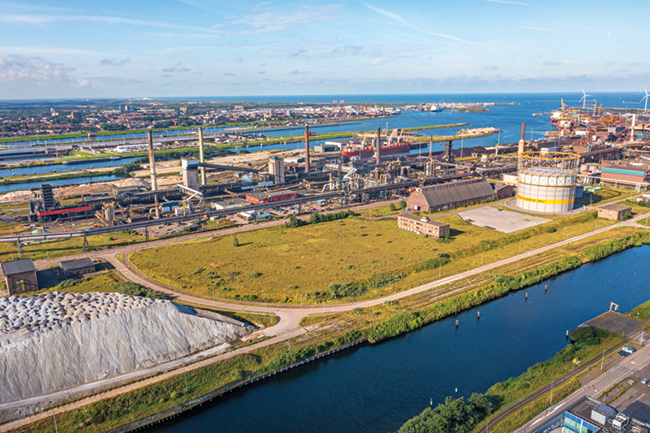
Committed to environmental excellence, Tata Steel IJmuiden Works
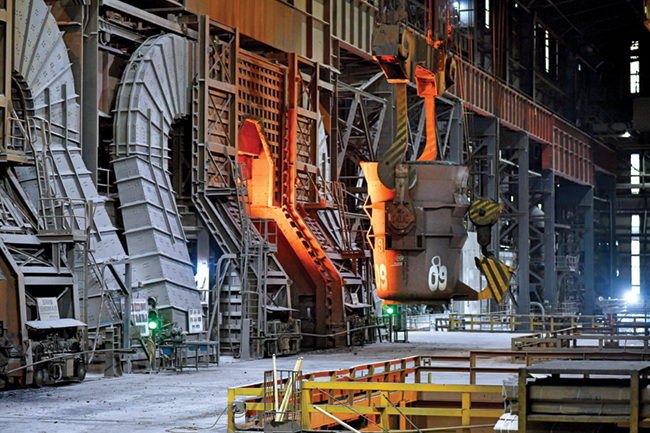
State-of-the-art steelmaking facility, Tata Steel Jamshedupr Works